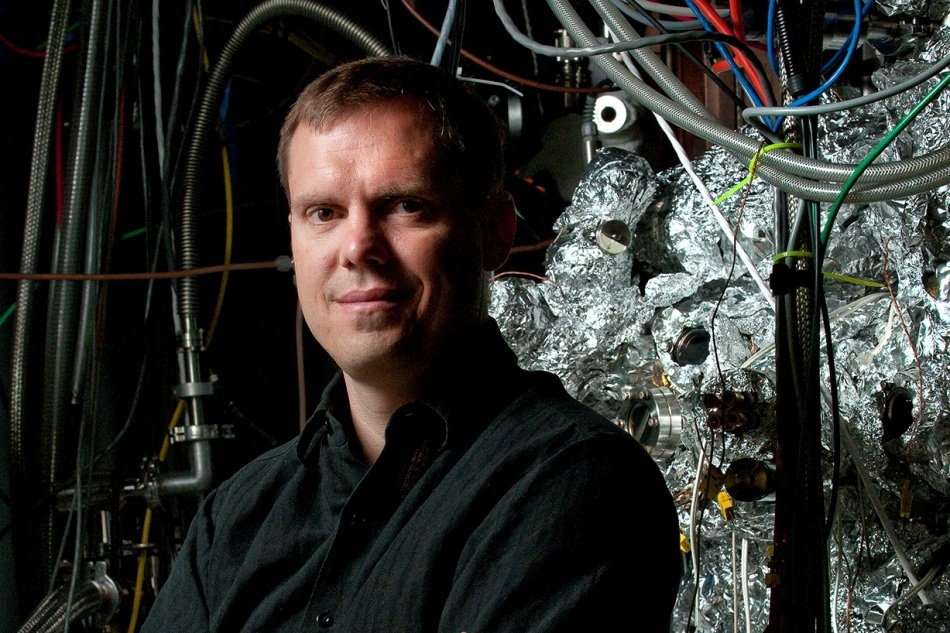Nov 1 2018
Scientists can develop the perfect molecule to tweak a gene, treat cancer, or guide the development of a stem cell, but none of that will be a success in the end if they cannot get their molecule into the human cells they want to influence. The solution to that problem, illustrated in a research published in the October 31st issue of Science Advances, could be tiny nanostraws, minute glass-like protrusions that poke equally minuscule holes in cell walls to deliver their cargo.
 A team led by materials science engineer Nicholas Melosh has developed tiny nanostraws that can deliver molecules into cells more precisely, faster and safer than other methods. (Image credit: L.A. Cicero)
A team led by materials science engineer Nicholas Melosh has developed tiny nanostraws that can deliver molecules into cells more precisely, faster and safer than other methods. (Image credit: L.A. Cicero)
A research team headed by Nicholas Melosh, an associate professor of materials science and engineering, first commenced testing nanostraws around five years ago using comparatively tough cell lines derived from mouse cells, cancers, and other sources. Currently, Melosh and colleagues have demonstrated that the method works in human cells as well, a result that could accelerate biological and medical research and could, in the future, enhance gene therapy for diseases of the immune system, eyes, or cancers.
“What you’re seeing is a huge push for gene therapy and cancer immunotherapy,” said Melosh, who is also a member of Stanford Bio-X, Stanford ChEM-H, and the Wu Tsai Neurosciences Institute, but prevailing methods do not match up to the challenge of delivering materials to all the applicable human cell types, particularly immune cells. “They’re really tough compared to almost all other cells that we’ve handled,” he said.
Crossing the cell membrane
Conveying chemicals across the cell membrane and into the cell itself is not a new concept, but there are several issues with the techniques researchers have until now depended on. In one common technique, known as electroporation, scientists use an electric current to open up holes in cell walls via which molecules such as proteins or DNA can diffuse through, but the technique is indefinite and can destroy many of the cells the scientists are attempting to work with.
In another technique, scientists use viruses to transport the molecule of interest across a cell wall, but the virus itself holds risks. While there are similar approaches that substitute viruses with more benign chemicals, they are less effective and precise.
That was the situation until just five or six years ago, when Melosh and colleagues put forth a new method of transporting molecules into cells, based on Melosh’s know-how in nanomaterials. They would employ electroporation, but do it in a massively more precise way using nanostraws, which because of their comparatively long, narrow profile help concentrate electric currents into a very tiny space.
Then, they tested that method on animal cells placed atop a bed of nanostraws. When they switched on an electric current, the nanostraws opened miniature, regularly sized pores in the cell membrane—enough that molecules can enter in, but not sufficient to do critical damage.
The electric current was useful for another purpose as well. Instead of waiting for molecules to haphazardly float through the newly opened pores, the current attracted the molecules straight into the cell, increasing the precision and speed of the process. The question then was whether the method would be as effective on the kinds of human cells clinicians would need to influence to treat diseases.
Faster, safer, more precise
In the new paper, Melosh and team demonstrated that the answer was yes—they effectively transported molecules into three human cell types as well as mouse brain cells, all of which had been hard to work with in the past.
Furthermore, the technique was faster, more precise, and safer than other approaches. The nanostraw method took merely 20 seconds to deliver molecules to cells, compared with days for certain approaches, and destroyed fewer than 10% of cells, a huge improvement over typical electroporation.
Melosh and his lab are currently aiming to test the nanostraw technique in some of the hardest to manipulate with cells, human immune cells. If they are successful, it could be a huge step not just for scientists who want to alter cells for research commitments but also for medical doctors aiming to treat cancer with immunotherapy, which currently involves adjusting a person’s immune cells using viral approaches. Nanostraws would not only avoid that danger but could potentially accelerate the immunotherapy process and decrease its cost as well, Melosh said.
Melosh is also an associate professor of photon science. Additional Stanford authors include Richard Lewis, a professor of molecular and cellular physiology; Joseph Wu, the Simon H. Stertzer, MD, Professor and a professor of radiology; postdoctoral fellow Ruoyi Qiu; and graduate students Yuhong Cao and Angela Zhang.
The study was financed by grants from the National Institutes of Health, the National Science Foundation, the Knut and Alice Wallenberg Foundation, and the Wu Tsai Neurosciences Institute.